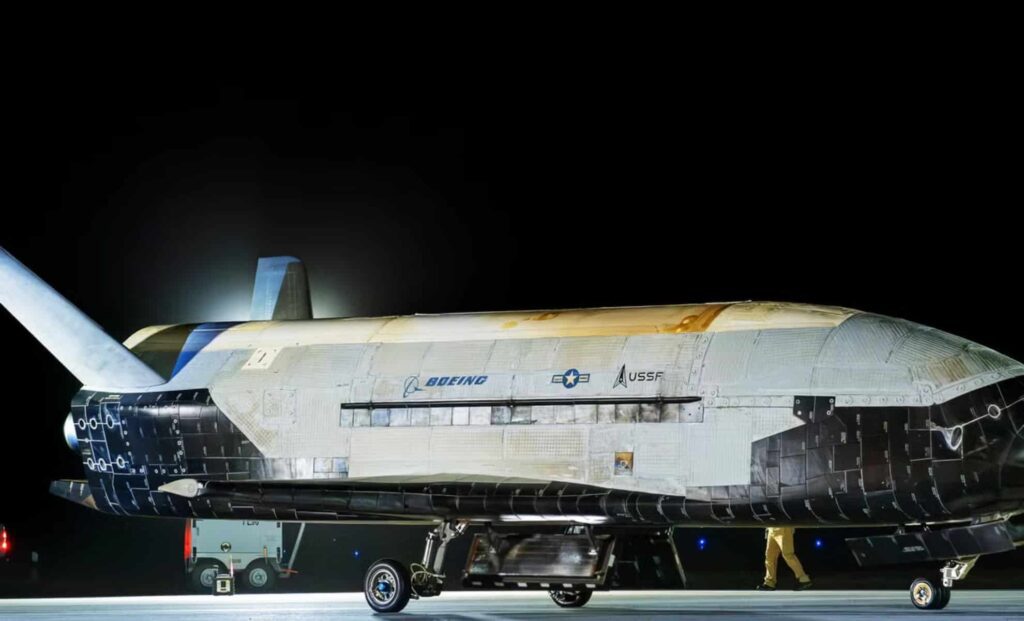The X-37B military spaceplane has successfully completed its seventh mission after spending 434 days in orbit, marking another significant achievement for the U.S. Space Force. The spacecraft, known as the Orbital Test Vehicle-7 (OTV-7), returned to Earth on March 7, 2025, after demonstrating cutting-edge orbital maneuvers and performing a series of critical experiments in space. This mission, launched aboard a SpaceX Falcon Heavy rocket on December 28, 2023, further advances the military’s capabilities in orbital maneuvering and space domain awareness.
A Groundbreaking Mission in Space Operations
OTV-7 broke new ground by operating in a highly elliptical Earth orbit (HEO)—an orbital regime that had not been fully explored by the Space Force before. This allowed the X-37B to conduct unique experiments that would be difficult or impossible in traditional orbital configurations. The mission was notable not just for its length but also for the advanced orbital maneuvers demonstrated by the X-37B, which had the ability to change its trajectory without visible propulsion signatures, allowing for greater operational flexibility in space.
The spacecraft’s stealth capabilities and advanced orbital adjustments showcase an evolution in how the U.S. military approaches space operations. The aerobraking technique—a method that utilizes atmospheric drag to alter an object’s orbit—was tested for the first time in this mission. According to a report on SpaceNews, aerobraking allows spacecraft to use the Martian atmosphere or a similar thin atmosphere to slow down and change their trajectory, conserving fuel while executing maneuvers in space. This technique could be especially useful for military space missions, where fuel conservation and orbital secrecy are crucial.
The mission also played an essential role in space domain awareness, as orbital maneuvers have critical applications for space surveillance and tracking potential threats in orbit. Space is increasingly becoming a contested domain, and the ability to maneuver in orbit, evade detection, and change course rapidly is vital for national security.
New Technologies for Future Military Space Operations
During its mission, the X-37B demonstrated a range of technologies that will likely shape the future of military space operations. The orbital test vehicle served as a platform for several NASA experiments, including testing new space technologies designed to enhance future missions to the Moon and Mars. These include miniaturized experiments and next-generation thermal management systems, which are critical for sustaining long-term space missions.
Additionally, the mission showcased how the X-37B’s highly classified capabilities can support both military and civilian objectives. The spacecraft conducted a series of space experiments aimed at advancing the science of space travel, helping prepare for future missions, including those targeting deep-space exploration and interplanetary journeys. Although many details about the classified nature of its operations remain undisclosed, the X-37B continues to be a cornerstone of the Space Force’s strategic vision for the future of space warfare and advanced technology testing.
The Strategic Impact of the X-37B’s Successful Mission
What makes the X-37B unique is its ability to conduct missions with unmatched secrecy while performing complex operations in orbit. Its orbital maneuvering capabilities make it a highly valuable asset for national security, particularly for covert operations in space. By altering its orbit and changing its position without detectable propulsion, the X-37B can potentially evade adversary surveillance and stealthily conduct military reconnaissance.
This mission also highlights the increasing importance of orbital agility, where the ability to maneuver in space is becoming as important as traditional capabilities on the ground. It paves the way for future space missions, where technology like this could be used to survey and protect U.S. satellites, track space debris, and even respond to space-based threats. The X-37B’s unique capacity to remain in orbit for extended periods allows the U.S. military to maintain a persistent presence in space, ensuring that it has the upper hand in any space-based conflicts.
In addition to its role in national defense, the X-37B’s demonstrations of advanced orbital technologies are setting the stage for a new era in space exploration, where military and civilian capabilities can complement each other for broader scientific and strategic goals.

